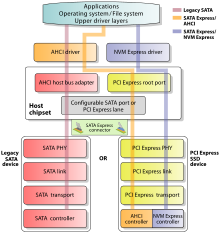SATA Express
SATA Express (SATAE) is the successor of SATA 6G a mass storage - interface . It was introduced in 2013 with the SATA 3.2 specification.
The SATA Express connector is backwards compatible with old SATA connectors and is therefore made up of three parts, one section is used to transmit the clock signal from PCI Express (PCIe) and for power supply, the other two sections serve as two alternative SATA slots. PCI Express is used for transmission; the clock rate used is around 33 percent higher than SATA 6G. However, if a SATA device is connected, the slower SATA controller is used.
SATA Express can use 1 or 2 PCIe 3.0 lanes (data transmission channels).
M.2 is the more powerful alternative to SATA Express. Despite its smaller form factor , it supports up to 4 PCIe lanes just like U.2 and is therefore faster than SATA Express.
SATA Express was already obsolete when it was released due to the limitation to two PCIe lanes (approx. 2 GB / s with PCI Express 3.0), as the drives released on the market required higher bandwidths in order to be able to access full performance. Therefore, M.2, which supports up to four lanes, also spread as an alternative for desktop PCs and notebooks. As a result, no SATA Express drives have appeared on the market either.
swell
- Entry in the electronics compendium
- Serial ATA Revision 3.2 (Gold Revision) ( Memento from March 27, 2014 in the Internet Archive )
Web links
Individual evidence
- ↑ SSDs or HDDs with SATA-Express available? The week's letter to the editor . In: PC Games Hardware . ( pcgameshardware.de [accessed on July 12, 2018]).

